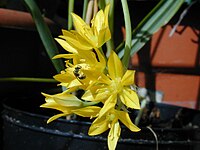Monocotyledon reproduction

Monocotyledons are plants with only one seed leaf, which is called a cotyledon. These plants reproduce sexually, meaning they rely on male and female reproductive organs to make new plants.
The male reproductive organ is called the stamen and consists of two parts: the filament and the anther. The filament is like a thin stem that holds up the anther, which looks like a little sack. Inside that sack are tiny grains called pollen.
The female reproductive organ is called the pistil and is located in the center of the flower. It consists of three main parts: the stigma, the style, and the ovary. The stigma is a sticky surface on top of the pistil where the pollen grains stick when they land on it. The style is like a little tube that connects the stigma to the ovary. The ovary contains the egg cells, which is where the plant's seeds are formed.
When a plant needs to reproduce, it usually relies on a little help from insects, birds, or the wind. These creatures carry the pollen from one flower to another, depositing it onto the sticky stigma of another flower. Once the pollen lands on the stigma, it begins to grow a tube down the style and into the ovary. When the pollen tube reaches the ovary, it fertilizes an egg cell and creates a seed.
Once the seed has formed, it is carried away by the wind or other creatures until it lands in a good spot to grow into a new plant. When the seed finally germinates (starts growing), the first thing that emerges is a little shoot called a cotyledon. This little cotyledon will soon sprout leaves and begin photosynthesizing, or making food from sunlight. And just like that, the plant has completed its life cycle and begun a new generation!
The male reproductive organ is called the stamen and consists of two parts: the filament and the anther. The filament is like a thin stem that holds up the anther, which looks like a little sack. Inside that sack are tiny grains called pollen.
The female reproductive organ is called the pistil and is located in the center of the flower. It consists of three main parts: the stigma, the style, and the ovary. The stigma is a sticky surface on top of the pistil where the pollen grains stick when they land on it. The style is like a little tube that connects the stigma to the ovary. The ovary contains the egg cells, which is where the plant's seeds are formed.
When a plant needs to reproduce, it usually relies on a little help from insects, birds, or the wind. These creatures carry the pollen from one flower to another, depositing it onto the sticky stigma of another flower. Once the pollen lands on the stigma, it begins to grow a tube down the style and into the ovary. When the pollen tube reaches the ovary, it fertilizes an egg cell and creates a seed.
Once the seed has formed, it is carried away by the wind or other creatures until it lands in a good spot to grow into a new plant. When the seed finally germinates (starts growing), the first thing that emerges is a little shoot called a cotyledon. This little cotyledon will soon sprout leaves and begin photosynthesizing, or making food from sunlight. And just like that, the plant has completed its life cycle and begun a new generation!
Related topics others have asked about:
